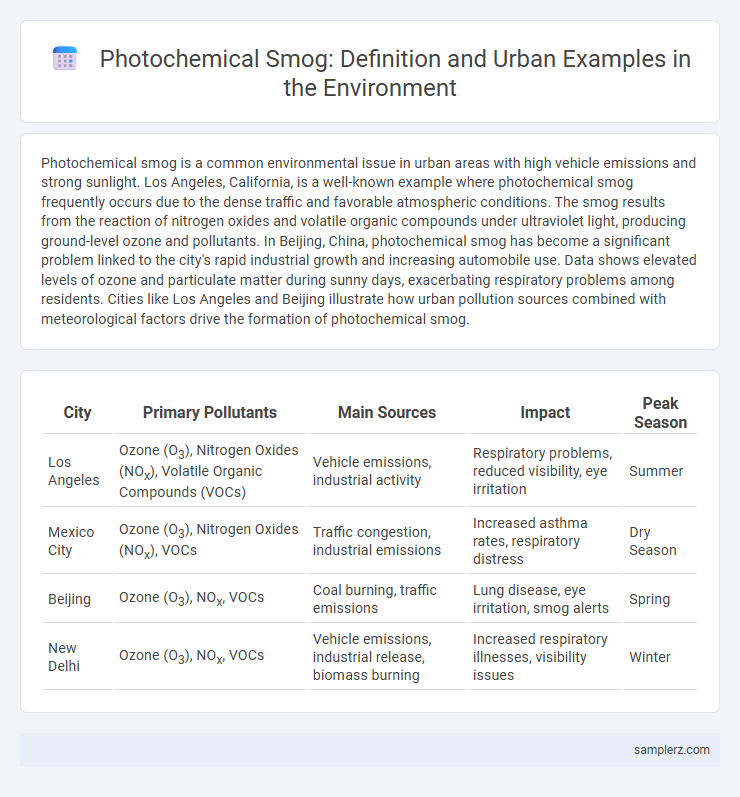Photochemical smog is a common environmental issue in urban areas with high vehicle emissions and strong sunlight. Los Angeles, California, is a well-known example where photochemical smog frequently occurs due to the dense traffic and favorable atmospheric conditions. The smog results from the reaction of nitrogen oxides and volatile organic compounds under ultraviolet light, producing ground-level ozone and pollutants. In Beijing, China, photochemical smog has become a significant problem linked to the city's rapid industrial growth and increasing automobile use. Data shows elevated levels of ozone and particulate matter during sunny days, exacerbating respiratory problems among residents. Cities like Los Angeles and Beijing illustrate how urban pollution sources combined with meteorological factors drive the formation of photochemical smog.
Table of Comparison
| City | Primary Pollutants | Main Sources | Impact | Peak Season |
|---|---|---|---|---|
| Los Angeles | Ozone (O3), Nitrogen Oxides (NOx), Volatile Organic Compounds (VOCs) | Vehicle emissions, industrial activity | Respiratory problems, reduced visibility, eye irritation | Summer |
| Mexico City | Ozone (O3), Nitrogen Oxides (NOx), VOCs | Traffic congestion, industrial emissions | Increased asthma rates, respiratory distress | Dry Season |
| Beijing | Ozone (O3), NOx, VOCs | Coal burning, traffic emissions | Lung disease, eye irritation, smog alerts | Spring |
| New Delhi | Ozone (O3), NOx, VOCs | Vehicle emissions, industrial release, biomass burning | Increased respiratory illnesses, visibility issues | Winter |
Introduction to Photochemical Smog in Urban Environments
Photochemical smog in urban environments, such as Los Angeles, forms when nitrogen oxides and volatile organic compounds emitted by vehicles and industrial activities react under sunlight to create ozone and secondary pollutants. This harmful air pollution significantly reduces air quality, exacerbating respiratory problems and environmental degradation. Understanding photochemical smog's chemical formation and sources is crucial for implementing effective urban air quality management strategies.
Causes of Photochemical Smog in Cities
Photochemical smog in cities primarily results from the reaction between nitrogen oxides (NOx) and volatile organic compounds (VOCs) emitted by vehicles, industrial processes, and power plants under intense sunlight. High temperatures and stagnant atmospheric conditions accelerate the formation of ozone and other harmful oxidants, contributing to dense smog layers. Urban areas with heavy traffic congestion and industrial emissions are most susceptible to this type of air pollution, impacting public health and visibility.
Major Cities Impacted by Photochemical Smog
Los Angeles, Mexico City, and Beijing are major cities severely impacted by photochemical smog due to high vehicle emissions and industrial pollutants. These urban areas experience increased ground-level ozone concentrations leading to respiratory issues and reduced air quality. Persistent smog in these cities disrupts ecosystems and exacerbates climate change effects.
Case Study: Los Angeles and Photochemical Smog
Los Angeles is a prime example of photochemical smog caused by high levels of nitrogen oxides (NOx) and volatile organic compounds (VOCs) from vehicle emissions and industrial activities. The region's intense sunlight and temperature inversions exacerbate the formation of ozone, a key component of photochemical smog, leading to significant air quality challenges. Regulatory measures targeting emission reductions have been implemented to mitigate health risks and improve atmospheric conditions in the city.
Photochemical Smog Episodes in Beijing
Photochemical smog episodes in Beijing are characterized by high concentrations of ozone and other pollutants formed from vehicle emissions and industrial activities under intense sunlight. These smog events significantly reduce air quality, causing respiratory problems and visibility issues for millions of residents. Mitigation efforts focus on regulating traffic emissions and promoting clean energy to decrease the frequency and severity of photochemical smog in the city.
The Role of Vehicle Emissions in Urban Smog
Vehicle emissions are a primary source of nitrogen oxides (NOx) and volatile organic compounds (VOCs), which react under sunlight to form photochemical smog in urban areas. Cities with high traffic density, such as Los Angeles, experience significant smog formation due to these pollutants. Controlling vehicle emissions through cleaner fuels and emission standards greatly reduces the intensity of urban smog episodes.
Health Effects of Photochemical Smog on City Residents
Photochemical smog, prevalent in cities like Los Angeles, is formed by the reaction of sunlight with pollutants such as nitrogen oxides and volatile organic compounds. Exposure to this smog causes respiratory issues including asthma, bronchitis, and decreased lung function, especially among children and the elderly. Long-term inhalation increases the risk of chronic respiratory diseases and cardiovascular problems, significantly impacting public health.
Policies Combating Photochemical Smog in Megacities
Megacities such as Los Angeles and Beijing have implemented stringent air quality regulations targeting vehicle emissions and industrial pollutants to combat photochemical smog. Policies include the enforcement of low-emission zones, promotion of electric and hybrid vehicles, and investment in public transportation infrastructure. Continuous monitoring systems and public awareness campaigns further enhance the effectiveness of smog reduction strategies in densely populated urban areas.
Innovations for Urban Smog Reduction
Innovations for urban smog reduction include the deployment of electric public transit systems in cities like Los Angeles, significantly cutting nitrogen oxide emissions that contribute to photochemical smog formation. Advanced air filtration technologies in urban infrastructure help trap particulate matter, while green rooftop initiatives increase vegetation cover, enhancing urban air quality by absorbing pollutants. Implementation of real-time pollution monitoring networks enables targeted traffic management, reducing ozone precursors and mitigating photochemical smog episodes effectively.
Future Outlook: Photochemical Smog in Growing Cities
Rising urbanization and increased vehicle emissions in cities like Los Angeles and Delhi contribute to worsening photochemical smog, threatening air quality and public health. Advances in electric vehicle adoption and stricter emission standards aim to reduce nitrogen oxides and volatile organic compounds, key precursors of smog. Continued investment in green infrastructure and real-time air quality monitoring technologies will be critical for mitigating future smog challenges in rapidly expanding metropolitan areas.

example of photochemical smog in city Infographic
 samplerz.com
samplerz.com